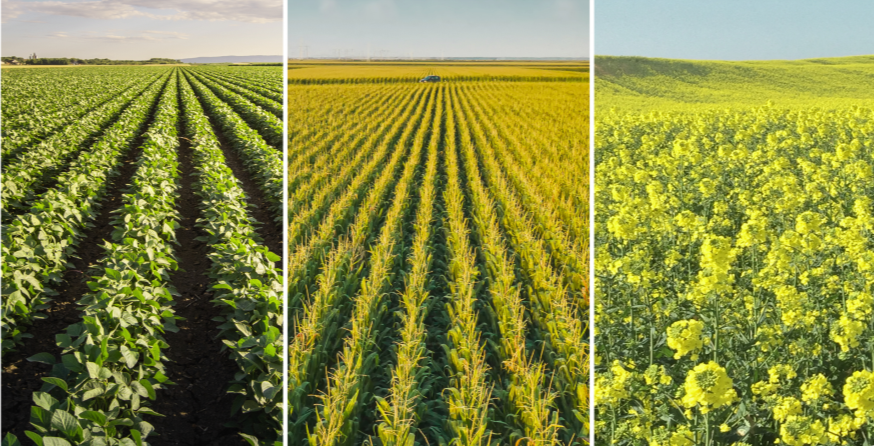A spotlight on the main Non-GM crops in the EU

The new market report highlights the major trends and recent developments that affect Non-GM supply and demand within the EU in the current (2023/24) marketing year.
The report finds that the availability of local Non-GM soybeans in the EU is expected to greatly improve in the 2023/24 marketing season, as the result of a record harvest in the region. Experts forecast that Brazilian Non-GM soy production is likely to reach almost 3 million mt in the current marketing season (2023/24).
In addition, low Non-GM premiums and moderating food inflation in the EU are likely to lead to good demand for Non-GM products this season. All three crops featured in this market report – soybean, maize & rapeseed – look well supplied both in the EU and on the global market in 2023/24, which will impact prices in the longer term.
Demand for Non-GM soy in the EU
Non-GM soy demand in Europe is likely to remain stable throughout the 2023/24 marketing season because of the great availability of local (European) Non-GM soybean from the 2023 harvest. In addition, low Non-GM soymeal premiums make Non-GM feeding programs more attractive and there is increasing demand for regional and deforestation-free materials in Europe.
Non-GM soybean and soymeal prices
EU Non-GM soy prices have declined over the last 3 months, driven by forecasts for an abundant soy output and stocks in the global soybean market for the 2023/24 marketing season. The October price level was 20% lower when compared to prices at the end of August. Non-GM soymeal premiums in the EU remained relatively stable and at historic low levels over the recent half year.
Non-GM soybeans: EU output
EU soybean output is forecast to grow to a record 3 million tonnes in 2023, up 33% (+ 740,000 t) against 2022, due to higher yields. Soybean yield in the EU is projected to be above the 5-year average in 2023. The record crop in the EU/Europe should mean, in the short term, greater availability of local (and regional) Non-GM soybeans within the EU, as well as further improvement in the Ukrainian export potential of Non-GM soy to the EU.
Non-GM soy production in Brazil
In Brazil, which is the biggest soy producer worldwide, a record soy area is predicted in the current season (2023/24). Experts forecast that Brazilian Non-GM soy production is likely to reach almost 3 million t in the current marketing season (2023/24). This volume is similar to the previous year and should be enough to supply all current export programs to Europe in 2024 (Europe is the main destination of Non-GM soy materials produced in Brazil).
At the start of the sowing period in September, several economic factors affected the decision of Brazilian farmers whether to plant GM or Non-GM varieties this season, including the current low level of Non-GM soy premiums in Europe, the seed costs of Non-GM varieties, which have declined over the last three months in Brazil, while GM seed prices have climbed. In the previous season, Non-GM yields reached higher levels than their GM peers. This happened the first time in history since GM soy varieties became mainstream.
Non-GMO Maize
The overwhelming majority of maize in the EU market is Non-GM. The share of GM is roughly 1% of the EU’s domestic output and roughly 20% of the EU maize import.
Maize output in the EU-27 is forecast to expand to 59.9 million t in 2023, up 12.7% compared to 2022. Euronext maize price moved at 202 EUR/t at the end of October, down 4% versus one month earlier. A key watchpoint on the maize market is the harvest progress in the USA and the situation in the Black Sea region. EU maize import is likely to remain at a relatively high level of 25 million t in the 2023/24 marketing season. When it comes to supply, there is unlikely to be a shortage of Non-GM feed grain in the EU throughout the 2023/24 marketing season. The recovery of the EU maize crop and the export potential of Ukraine ensure that EU Non-GM maize demand is covered.
Non-GMO Rapeseed
As with maize, Non-GM is the standard quality in the EU rapeseed market. Rapeseed output in the EU-27 is estimated at 19.8 million t in 2023, up 1% (+ 200,000 t) from last year’s harvest. Rapeseed supply in the EU, therefore, remains comfortable for the 2023/24 season after a relatively good harvest and excessive stock build-up from the previous season. Euronext rapeseed price continued to drop and moved to 421 EUR/t at the end of October. The global market looks well supplied for the 2023/24 season, with expected strong outputs in the EU, Ukraine, Canada and Australia in 2023/24. This will put downward pressure on prices. In the longer term, the global rapeseed market looks well supplied.